The thorny devil is a species of lizard in the Agamidae family. It is also referred to as the mountain devil, thorny lizard, thorny dragon, and moloch. The species only occurs in Australia, and it is the only species in the genus moloch. It can reach a maximum length of 21 cm, with females often larger than males. To learn more, read the following 10 incredible thorny devil facts!
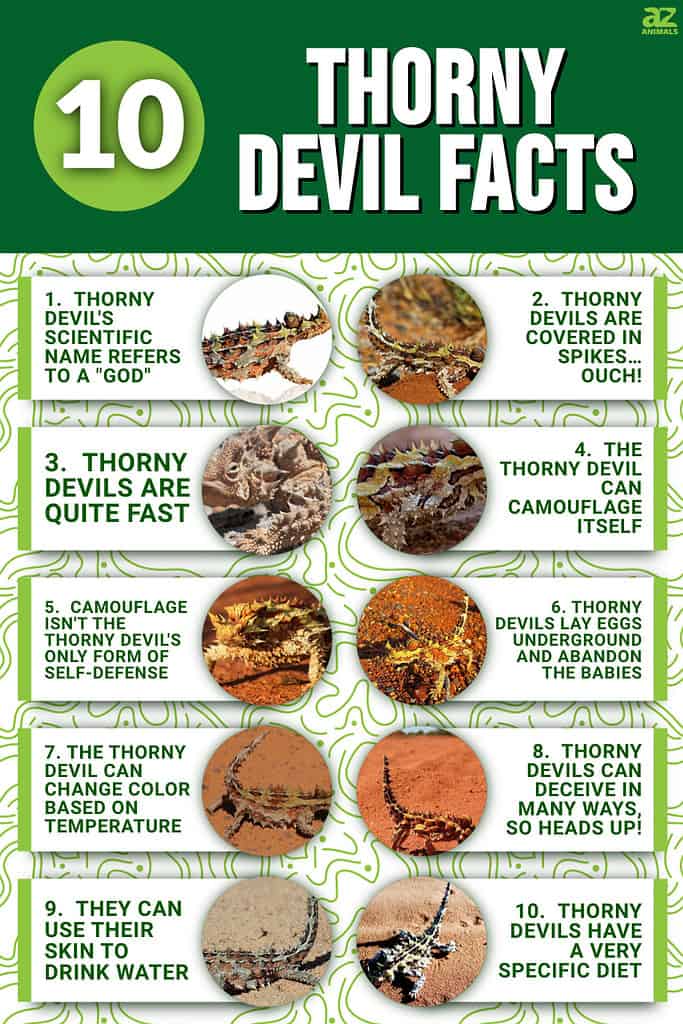
1. Thorny devil’s scientific name refers to a “god”

The devilishly prickly species was given the Latin name moloch horridus as a tribute to John Milton’s epic poem “Paradise Lost.”
©ChameleonsEye/Shutterstock.com
The thorny devil gets his name from an ancient god who insisted on human sacrifice. The devilishly prickly species was given the Latin name moloch horridus as a tribute to John Milton’s epic poem “Paradise Lost.” In the poem, the Canaanite god “Moloch” was linked to the ritual killing of humans. In Latin, the word horridus can also mean bristly or harsh.
2. Thorny devils are covered in spikes… Ouch!

Thorny Devils have sharp spikes all over to protect them from predators.
©Leith Holtzman/Shutterstock.com
To protect themselves against predators, they are armored in sharp spikes and sturdy scales. Because of this, they are dangerous to predators that come into contact with them, as they are tough to swallow.
3. Thorny devils are quite fast

Thorny devils can reach speeds of up to 37 mph!
©John Carnemolla/Shutterstock.com
It has been reported that they can reach speeds of up to 37 miles per hour! They tend to freeze in place when they detect danger, although they can make a quick getaway if necessary.
This horridus reptile, so named because of its erect stance, is a pretty harmless, slow-moving, day-feeding ant-feeder. The “fake” head on its neck and the spiky spines all over it are there to scare off potential predators.
4. The thorny devil can camouflage itself
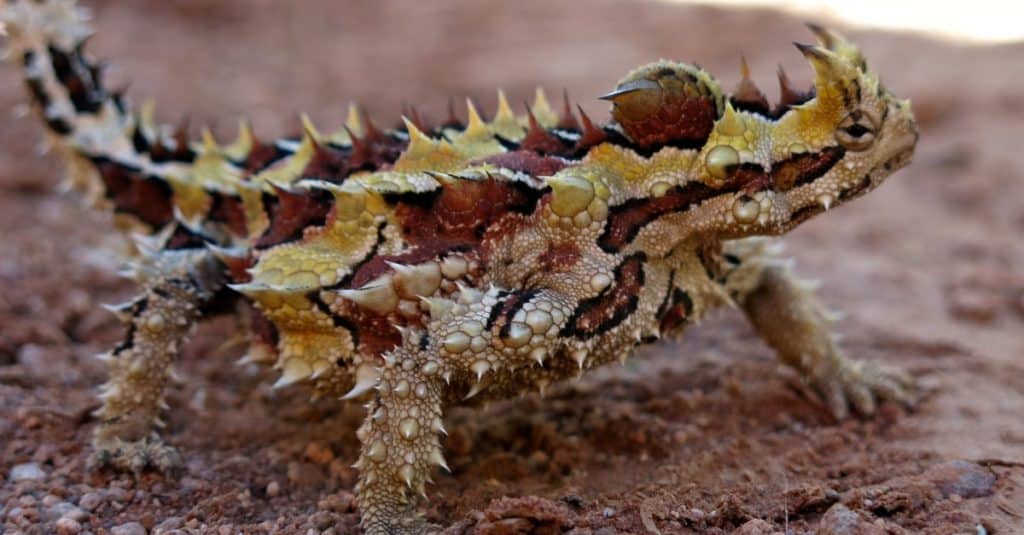
Thorny devils change colors to blend into their environment.
©iStock.com/witte-art_de
Their outer layer colors blend in well with the wild. As a matter of fact, it can change its appearance to mimic the range of browns and tans typically found around the desert.
Environment, time of day, and geographical location are just a few factors that affect the rate at which their color shifts. In addition, this lizard has an odd walking pattern that consists of a pausing and swaying motion, which it utilizes to locate food, water, and potential partners.
5. Camouflage isn’t the thorny devil’s only form of self-defense
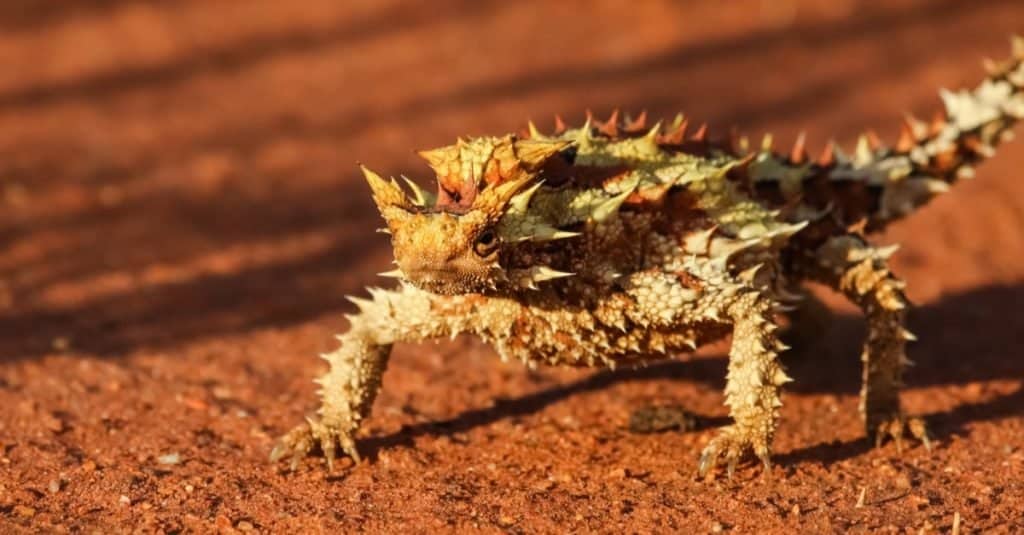
The thorny devil will fill its chest with lots of air to look bigger to predators.
©Uwe Bergwitz/Shutterstock.com
The thorny devil may fully inflate its chest with air to scare away potential predators. This makes them more challenging to swallow and appear larger to predators. It also makes them seem even more gruesome than they already do!
6. Thorny devils lay eggs underground and abandon the babies

Thorny Devils will nest in burrows up to 30cm deep.
The nesting period for up to ten eggs typically occurs from September to December. In a nesting burrow about 30 centimeters deep, the eggs will remain for around three to four months before hatching.
Thorny devil offspring are essentially independent as soon as they emerge from their eggs. There is a wide range of incubation times depending on environmental conditions. The success rate of hatchlings and juveniles depends on whether goannas or other predatory birds get to them first.
7. The thorny devil can change color based on temperature

The temperature will affect the color of the Thorny devil.
©Wouter! (Retuow) / CC BY-SA 3.0, via Wikimedia Commons – License
As learned earlier, thorny demons can alter their appearance by changing hue. You can tell whether the thorny devil is hot or cold by its color. When thorny devils cool, their colors change from white to a much darker brown, regardless of sex.
During the warmer months, the lizards have bright yellow and red coloring; however, the lizards can rapidly transition to darker colors in colder climes or when disturbed.
8. Thorny devils can deceive in many ways, so heads up!
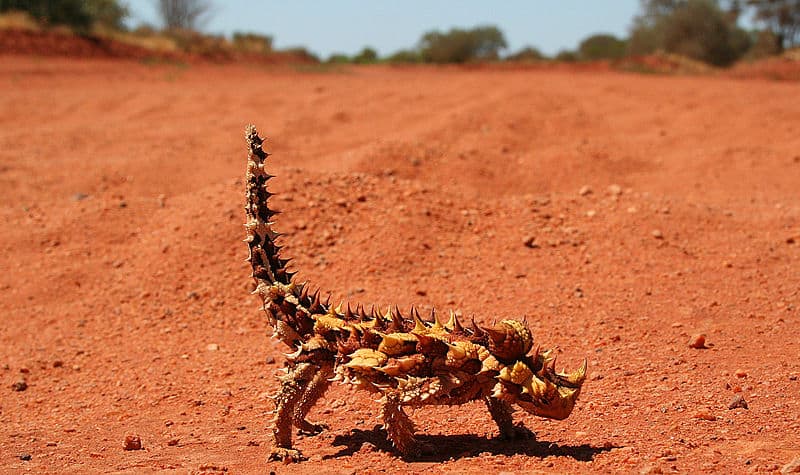
Thorny Devils have a false head they use to trick predators
They feature a spiny “false head” on the back of their neck. To show off their genuine head to potential predators, they lower it between their forelegs. A dummy “second” head made of soft tissue serves as its “upper” body. Pretty mind-blowing, right?
9. They can use their skin to drink water

Thorny Devils collect water in the cracks of their skin and direct it to their mouths.
The minuscule tubes and grooves in their skin can collect water and direct it to their lips, where they can swallow it. They drink the water that runs down their backs from the rain or while moving through damp conditions.
10. Thorny devils have a very specific diet
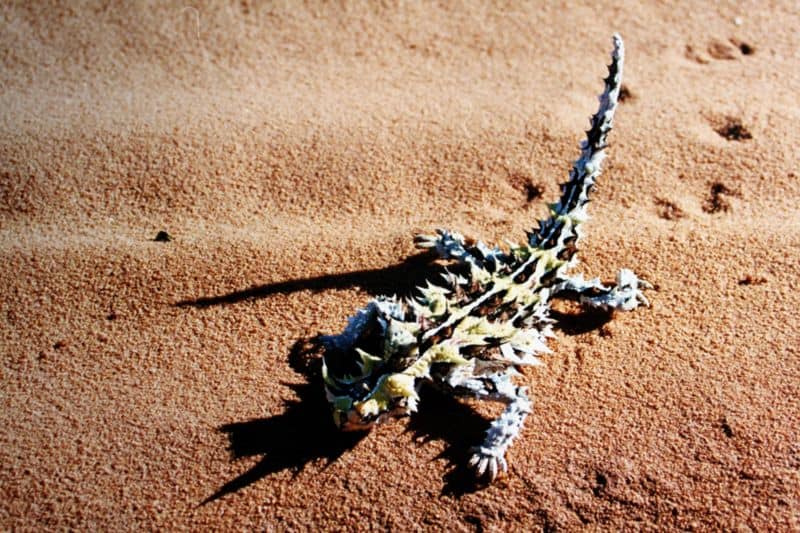
Thorny Devils love to eat ants! They can eat up to 3,000 in a single sitting.
Ants are the primary component of the Thorny Devil’s diet, and the creature is capable of consuming up to 3,000 of them in a single meal. They use their sticky lips to grab hold of them, and once they have them, they bite them apart to consume them.
Related Animals:
The photo featured at the top of this post is © Leith Holtzman/Shutterstock.com
Sources
- Wikipedia, Available here: https://en.wikipedia.org/wiki/Thorny_devil
- Fact Animal, Available here: https://factanimal.com/thorny-devil/
- Active Wild, Available here: https://www.activewild.com/thorny-devil-facts/
Thank you for reading! Have some feedback for us? Contact the AZ Animals editorial team.







